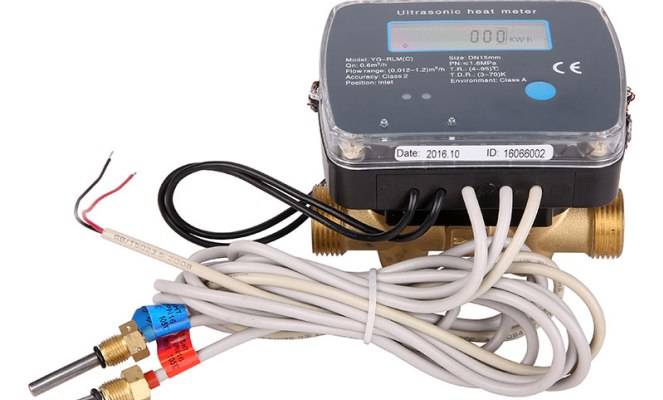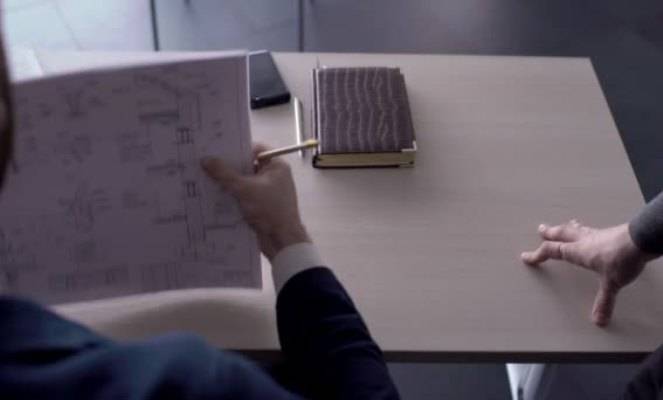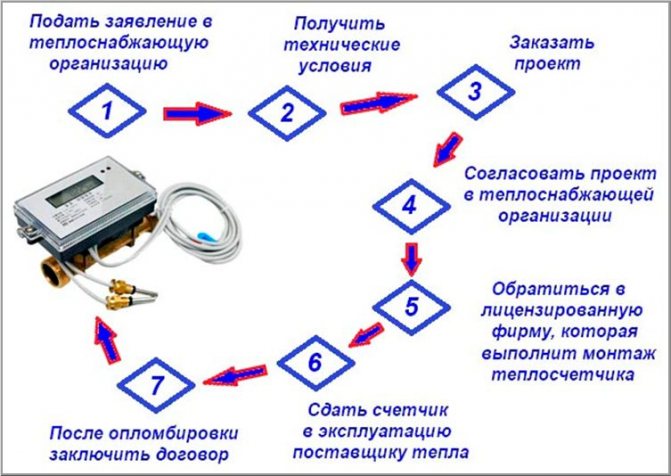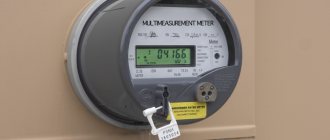Why are heat meters needed in apartments?
A heat meter is a device that allows you to control the amount of heat actually consumed. The calculation is based on measuring the temperature of the medium in the supply and return pipelines of the heating system.
Previously, the calculation of heat consumption was carried out according to general standards. They are still used today if there are no individual heating meters in an apartment building.
The standards were formed on the basis of the estimated (theoretical) amount of energy required to heat 1 m2 of living space for a month. The indicator was adjusted taking into account the type of building and average monthly air temperature. The standards included heat loss during transportation.
As a result, homeowners who did not have residential heat meters installed were forced to pay amounts that were 20-30% higher than actual costs.
Saving is the main reason for installing measuring instruments in apartments.
Consumers are accustomed to blaming heat suppliers for poor quality services and inflated tariffs. And often they are right: heating systems do not take into account sudden cold snaps and warming temperatures, so Russians either freeze or don’t know where to escape the heat.
Find out what the room temperature should be from the article “Temperature norms in an apartment during the heating season.”
But you should not relieve yourself of responsibility. Residents of high-rise buildings are not used to insulating their homes. If new buildings are maximally protected from heat loss, then in old houses things are much worse. Uninsulated windows, lack of front doors and much more lead to residents paying for unused heating.
Is it possible to install a heat meter in an apartment?
The question: is it allowed to install heat meters in an apartment still remains relevant.
The World Wide Web gives diametrically opposed answers. Perhaps the utility services themselves are misleading people, since they do not really benefit from such modernization. However, we cannot be fooled so easily; after reviewing the legislation, we made an unambiguous conclusion: it is possible to establish, but there are several nuances.
Please note that installing a heat meter in an apartment yourself is not only prohibited, but also very dangerous. Outside interference in the heating system can result in an accident, and if everything goes smoothly, then, in any case, it will not be accepted by the heating service.
If you decide to install such a meter, then you need to do everything according to the rules.
When installation is not possible
There is no legislation prohibiting the installation of your own meter, but there are cases when technically installing it simply does not make sense. This situation is possible in very old houses, where changing the heating system is impossible or not profitable.
Basically, the problem lies in the wiring of the heating system. It comes in two types:
- Vertical system. Heat passes through all floors up and then back. In this case, there are usually several risers per apartment, and a meter will have to be installed on each of them, which is very expensive. Most often, such heating is installed in Khrushchev-era buildings.
- Horizontal - has two pipes, heat enters through one, and through the other it goes out with one riser to the apartment. Therefore, installing a meter will not be a problem.
To be absolutely sure whether a heat meter can be installed in an apartment, contact a specialist. They will conduct an inspection and tell you how effective the modernization will be and how much it will cost to maintain this system.
Heat meters in the legislation of the Russian Federation
It is important to note that in the Russian Federation there is a law that obliges the installation of heat meters in an apartment building at the expense of the residents. If this is not done, then you will have to pay a tariff with a coefficient of 1.5, if not more.
In this case, it does not matter whether you have an individual meter for your apartment; its readings will not be taken into account. Therefore, first make sure that your house has a common meter, and then install an individual one according to the procedure established by law.
Legislation on the installation of metering devices
Owners of residential premises have the right to install in their houses and apartments not only gas and water meters, but also heat meters. This is provided for by the legislation of the Russian Federation. The following regulations regulate relations in this area:
- ;
- .
The Law on Individual Heat Metering Devices in Apartments stipulates that all houses put into operation from January 1, 2012 after construction or reconstruction should be equipped with individual heat metering devices.
High-rise buildings that have undergone major renovations must be equipped with heat meters if technically possible.
As for the rest of the housing, installation of monitoring equipment is the responsibility of the owners.
In 2020, the law was supplemented with provisions according to which the installation of heat metering devices can only be carried out by enterprises that supply energy resources and special equipment. They must be members of the SRO and have permission to perform this type of work.
Heating meters for apartments: pros and cons
It is well known that heat in an apartment building is distributed unevenly between different apartments. This means that if you try to save heat as much as possible, then your neighbor can easily live with ventilated windows, and you will have to pay the same amount. Accordingly, many apartment owners are trying to install individual heating meters in an apartment building.
Important! The main advantage of an individual heat meter is that each owner of the apartment in which it is installed will pay exclusively for the heat that was used to heat his apartment.
When installing individual heating meters in an apartment building, the pipe distribution system should also be taken into account. As a rule, in many multi-storey buildings built in the last 15-20 years, there is a horizontal distribution of pipes from risers - with such a system there are no obstacles to installing metering devices.
The meter is mounted on the pipe through which the coolant enters the apartment. In houses with an old layout, vertical pipe distribution was most often used - with such a structure, installing an individual heat meter can be difficult. As a rule, difficulties are associated with the fact that it is preferable to install meters on a riser, which can be several in the case of vertical wiring.
The best option for apartments with vertical wiring is the use of special distributors that effectively and accurately measure heat consumption, based on the contrast between the temperature readings on the surface of the radiator and directly in the air of the living room. Read more about installing an individual meter here.
Types of heat meters and their operating principles
Instruments for measuring water and gas consumption have long been familiar to Russians. But many people do not understand how a heat energy meter for an apartment works.
The number of heat meters installed in a room depends on the type of wiring. If it is horizontal, it is enough to install one device. Residents of houses with vertical pipes will face more serious expenses. They will have to install the device separately on each battery.
Each device consists of:
- 2 temperature sensors;
- coolant meter;
- calculator.
The operating principle of the heat meter is simple. Sensors determine the temperature of the medium at the entrance to the system and at the exit from it. The meter records the amount of water passing through the pipes and radiators of the apartment.
The heat meter can be installed both at the entrance and exit to the apartment heating system.
The computer analyzes the data received from the listed devices and determines the amount of heat used. This element runs on electricity. No mains connection is required, as its operation is powered by lithium batteries.
It is impossible to unequivocally answer the question of how much a heat meter costs. The cost depends on the manufacturer and type of device. Below we will consider in detail the types of equipment and their features.
Mechanical heat meters
The simplest and most accessible metering device is mechanical. It can be screw, turbine or vane. The equipment can be used even if the coolant is heavily polluted or saturated with salts.
Such a heat meter has its pros and cons. The main advantages are:
- simplicity and reliability of design;
- independence from electricity;
- ease of installation and maintenance;
- Possibility of installation in any position;
- stability of indicators.
Experts recommend installing a deep cleaning filter in front of the device. This will allow you to obtain accurate indicators over a long period.
Among the disadvantages of the device, it is noted that it has a short service life compared to other types.

Ultrasonic heat meters
The legislation of the Russian Federation allows for residential heat metering using various types of equipment. Ultrasonic models are considered the most reliable and durable.
During operation, they record the time of passage of ultrasound along the coolant flow from the source to the receiver. This period depends on the speed of the water: the higher it is, the longer the ultrasound travels.
The device records the signal delay and determines the volume of coolant used. Accurate measurements can be obtained in the absence of impurities and scale.
The consumer can choose between time, Doppler, frequency or correlation ultrasound counters.
Electromagnetic devices
Electromagnetic heating meters for apartment radiators determine the volume of coolant by creating an electromagnetic field. An electric current appears in the water passing through it. The unit detects the current voltage, which increases as the coolant flow accelerates. By assessing these indicators, the device determines the volume of liquid.
If the installation of such a heat meter was carried out by a qualified specialist, and the coolant passing through the device is cleared of impurities, you can guarantee that the device will give the most accurate readings.
Vortex counters
If you don’t know which heat meter is best to choose for your apartment so as not to spend extra money, pay attention to the vortex device.
Due to the design feature, a vortex of coolant is formed inside, which has a certain frequency. This indicator is proportional to the flow speed. After determining the frequency of vortex formation, the equipment calculates the volume of coolant used.
The main advantages of devices of this type are:
- low cost;
- simplicity of design;
- possibility of installation in horizontal and vertical pipelines;
- little wear.
During operation, vortex equipment does not use a large amount of electricity.
When giving preference to such devices, it should be taken into account that their installation requires a large straight section of pipe. In addition, the devices are sensitive to vibrations.

Installation of equipment
A home owner who has decided to control the consumption and quality of heat should seek advice from specialists. They will tell you how to install a heat meter in an apartment with central heating and help you choose the optimal model.
It should be remembered that even if you have some experience in construction, you cannot do the installation yourself. Manual installation may be the reason for refusal to register the device and re-register a personal account.
Who has the right to install heat meters?
Work on installing heat metering devices can only be carried out by specialists. The performer must:
- have permits (permit, certificate) issued by government agencies;
- be a member of the SRO.
Installing a heat meter in an apartment of an apartment building separately from other residents requires prior contact with a company that has permission to carry out installation.
Its staff will inspect the site to determine the feasibility of installation. Based on the results of the examination, the specialist will draw up an appropriate report.
Installation design and its approval
If installation is possible, you should contact the Housing Office (Management Company) to obtain an opinion on the technical conditions of the installation. To do this, you need to write an application and attach to it:
- a copy of the document confirming the ownership of the living space;
- registration certificate of the apartment.
After this, the contractor will prepare a project and coordinate it with the heat supply company.
Only after receiving the appropriate permission can you buy the device. Make sure the seller has provided the necessary documentation:
- passport,
- quality certificate,
- warranty card,
- cash and sales receipts.
Check for the presence of a stamp and a special sticker. They are confirmation that the equipment has passed initial testing at the manufacturer.

Installation and registration of a heat meter
Specialists from companies that install heat devices know well how to install heat meters on radiators in an apartment, and have the necessary equipment for this. The work is carried out in compliance with existing rules:
- heat meters are installed in accordance with the project;
- no changes are made to the approved project. Any modifications lead to its re-approval;
- installation is agreed upon individually. Standard diagrams for installing devices inside an apartment are not used;
- the specifics of the installation require the presence of straight sections of pipe on both sides of the device;
- installation is carried out so that the equipment can be easily removed for verification or repair without draining water from the system.
After completion of installation work, the device is sealed in the presence of:
- the specialist who performed the installation;
- representative of the Housing Office or Management Company;
- home owner.
The device is then registered with the company that controls the heating of the house.
How to install the counter?
If you want to install a heat meter in an apartment, then you need to do the following:
— make sure it can be installed. To do this, you need to call the specialists of the management company and draw up an inspection report that the installation of a metering device is technically possible;
— contact the management company and clarify what is needed to connect the meter in your apartment;
Question answer
What metering devices are required?
— choose and purchase a heat meter (mechanical, vortex, electromagnetic or ultrasonic). When purchasing, you must take cash receipts and sales receipts, a quality certificate, and an instruction manual;
- contact a specialized company that has a license to install heat meters. She must develop a project for installing a meter, which will still need to be agreed upon with the management company.
— after installing the meter, you will need to seal it in the presence of a representative of the management company.
After this, payment for heat supply services can be made according to the heat meter readings.
Question answer
Is it possible to dismantle the radiators in the apartment yourself and not pay for heating?
Is it always profitable and possible to install a heat meter?
In accordance with the legislation of the Russian Federation, the installation of water meters is mandatory. Since this requirement does not apply to heat meters, residents of apartment buildings are interested in whether it is profitable or not to install devices that take into account heat consumption.
It should be recognized that in some cases the purchase and installation of equipment may be a waste of money. There will be no benefit from purchasing the device if:
- the house is poorly insulated;
- there is no glazing in the entrances or its quality leaves much to be desired;
- The apartment has old windows and doors that do not prevent heat loss.
Installing a heat meter in an apartment located in a building where the use of devices is not intended will require large expenses. In this case, the cost of developing a project and performing non-standard installation work may be too high.
Many homeowners ask whether it is possible to install heating meters in an apartment with vertical wiring. Since heating is designed this way in almost all old high-rise buildings, let’s look at the situation in more detail.

Heat meters in houses with vertical system wiring
Residents of old houses who decide to control the quality of heating may encounter problems when installing heat meters. Difficulties arise already when obtaining permission, because the pipes in such buildings are usually in dilapidated condition.
An equally serious problem will be the installation of heat meters in an apartment with vertical wiring. It arises due to the fact that the equipment is usually installed on a riser, and with this type of wiring there may be several of them.
Owners of such housing will have to coordinate the installation, purchase and install equipment for each battery. As practice shows, such expenses are unjustified, because the money spent will never pay off.
To avoid unnecessary expenses, we recommend that you read the tips published in the article “Heating system of an apartment building.”
How to install an individual heat meter
The installation procedure for the IPU is not complicated if the steps are followed according to the step-by-step instructions:
- Installation of heat meters begins with a general meeting of owners of apartment buildings. Owners of apartments and non-residential premises must come to the decision that the house will be equipped with flow meters 100%.
- Coordination is being carried out with the resource supplying organization. The procedure will allow you to select a suitable model of the mechanism and determine a list of processes that must be performed in advance. The fewest problems arise in houses in which the wiring is arranged horizontally.
- It is recommended to assess the condition of the system in advance, on the basis of which it is easier to obtain installation specifications.
- Additionally, it is advisable for each owner to take care of increasing the energy efficiency of the living space: insulation is carried out, and places of possible heat leakage are eliminated.
- A project is being drawn up. An official commercial organization is involved, which is empowered to provide specific services. It is more profitable to carry out general door-to-door work, which will allow you to save significantly.
- Technical documentation is coordinated with the heat supply organization. Depending on the form of management of an apartment building, the involvement of a management company may be required.
- A company that will install the meter is selected and a contract is concluded. For everything to be legal, the chosen company must have permission to carry out the work. In some cases, it is more effective to invite a supplying organization.
- After installation, an application is submitted to the utility service provider to put the device into operation, which is accompanied by sealing and issuance of the corresponding certificate.

Coordination and installation of heat meters in apartment buildings is a lengthy process, and besides, the savings from such devices do not always justify the costs of them
If all work is carried out by the resource supplier or management company, difficulties can be avoided, because the contractor most often provides a full range of paid and free services.
With horizontal wiring of the heating system, an individual meter is most often installed outside the apartment in a special box. If you wish to move the mechanism indoors, you must obtain a separate permit.
Heat meters verification
The measuring instruments installed in the apartment require periodic verification. Heat meters are no exception. The procedure allows you to monitor the health of the equipment and determine the accuracy of heat consumption readings.
The devices undergo initial testing at the manufacturer. After this, heat metering sensors in the apartment should be tested every 4 years. To do this you need to contact:
- to a company providing such services on the basis of a license;
- to the manufacturer's service center;
- to the Rostest department.
The homeowner pays for the inspection.
Taking readings from a heat meter
Homeowners who have installed heat metering devices pay for services in accordance with meter readings. To determine the actual consumption, you need to subtract the previous indicator from the current indicator and multiply this figure by the regional tariff rate.
When calculating, indicators in gigacalories are used. Some devices measure heat consumption in kilowatts. To convert the reading to gigacalories, multiply the resulting figure by 0.0008598.

Find out more about how to take readings from a heat meter.
Common house meters
To regulate heat consumption, residents of many apartment buildings decided to install a common house heat meter. The device is attached to the main riser installed in the basement and controls the amount of heat supplied to the apartments of the house.
Apartment-by-apartment heat metering in an apartment building is a difficult task. A number of procedures are carried out monthly:
- Taking current indicators.
- Determination of the number of gigacalories consumed.
- Calculation of the total amount intended for payment.
- Apartment division of payment depending on the area of housing.
Residents of apartment buildings pay not only for the heat that was needed to heat their premises. The costs of the coolant used for heating are taken into account:
- front doors,
- landings,
- basements,
- attics.
The operating principle of a heat meter in an apartment building involves calculating the amount of energy spent to heat these premises. This heat will be reflected on residents' bills. Therefore, equal sharing of costs between residents often causes a negative reaction.
For more information about common house heat meters, read the article “Common house heat meter in an apartment building.”
Purpose of an apartment heating meter
Meters responsible for measuring the amount of heat are becoming increasingly popular. By installing such a device in your apartment, you will be able to control the consumption of thermal energy and, therefore, monitor how warm your home really is. Having such data, you can reduce costs and pay only for the heat received, and not for standard consumption rates.
Many users who doubt whether it is worth buying an apartment heat meter are wondering: how long will it take for such an acquisition to pay off?
Reviews from users who already have such devices indicate that installation costs are not very high, but savings will begin to be seen very soon. The tenant will not have to compensate for errors in the work of housing and communal services and heat loss in the system.
You can install either an individual heat meter for heating for an apartment or for an entire apartment building with central heating. There is a wide variety of models on the market today, differing in price and operating principle.











